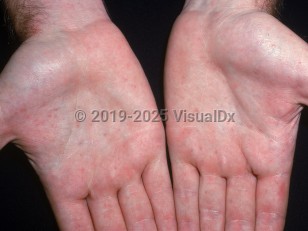Basal cell nevus syndrome in Adult
Alerts and Notices
Important News & Links
Synopsis

Basal cell nevus syndrome (BCNS), also known as Gorlin syndrome and nevoid basal cell carcinoma syndrome, is a rare condition that is usually inherited in an autosomal dominant fashion, although a high percentage of cases are sporadic. The majority of inherited cases are caused by PTCH1 gene mutations (50%-70% of cases), but PTCH2 and SUFU mutations have also been found to be responsible. The PTCH gene encodes a transmembrane receptor that recognizes sonic hedgehog signaling proteins. De novo mutations make up 20%-30% of BCNS cases.
BCNS affects men and women equally. While all races / ethnicities are affected, reports of affected Asian and Black individuals (both African Americans and Black South Africans) cite lower overall numbers of basal cell carcinomas (BCCs) or no BCCs at all. Further precise, active study of dermatologic findings in these populations is warranted to corroborate these findings.
The hallmark of the condition is the occurrence of multiple pigmented BCCs or nonpigmented BCCs beginning around puberty, or even in childhood. Areas of the face, torso, and extremities are involved, regardless of sun exposure. Palmoplantar pits are a further cutaneous feature.
BCNS may affect several systems, including skeletal, ocular, gastrointestinal, cardiovascular, genitourinary, and central nervous systems. Some of its extracutaneous manifestations include skeletal abnormalities (abnormal skull formation 70%, scoliosis 40%, spina bifida occulta 40%-60%), lymphomesenteric cysts, cleft lip / palate, and ovarian (6%-60%) and cardiac fibromas (3%-5%). Patients with SUFU mutations have a reported 20-fold increase in risk of developing medulloblastomas compared to patients with PTCH1 mutations.
Other associated anomalies include undescended testes, hydrocephalus, strabismus, congenital cataracts, nystagmus, blindness from coloboma, and glaucoma. Agenesis of the corpus callosum and intellectual disability are also reported.
Children with BCNS are at an increased risk for secondary malignancy after high-dose radiation. This includes the development of numerous BCCs in the field of irradiation months to years after exposure, and nervous system tumors (astrocytoma, craniopharyngioma, and oligodendroglioma) after radiation treatment of medulloblastoma.
BCNS affects men and women equally. While all races / ethnicities are affected, reports of affected Asian and Black individuals (both African Americans and Black South Africans) cite lower overall numbers of basal cell carcinomas (BCCs) or no BCCs at all. Further precise, active study of dermatologic findings in these populations is warranted to corroborate these findings.
The hallmark of the condition is the occurrence of multiple pigmented BCCs or nonpigmented BCCs beginning around puberty, or even in childhood. Areas of the face, torso, and extremities are involved, regardless of sun exposure. Palmoplantar pits are a further cutaneous feature.
BCNS may affect several systems, including skeletal, ocular, gastrointestinal, cardiovascular, genitourinary, and central nervous systems. Some of its extracutaneous manifestations include skeletal abnormalities (abnormal skull formation 70%, scoliosis 40%, spina bifida occulta 40%-60%), lymphomesenteric cysts, cleft lip / palate, and ovarian (6%-60%) and cardiac fibromas (3%-5%). Patients with SUFU mutations have a reported 20-fold increase in risk of developing medulloblastomas compared to patients with PTCH1 mutations.
Other associated anomalies include undescended testes, hydrocephalus, strabismus, congenital cataracts, nystagmus, blindness from coloboma, and glaucoma. Agenesis of the corpus callosum and intellectual disability are also reported.
Children with BCNS are at an increased risk for secondary malignancy after high-dose radiation. This includes the development of numerous BCCs in the field of irradiation months to years after exposure, and nervous system tumors (astrocytoma, craniopharyngioma, and oligodendroglioma) after radiation treatment of medulloblastoma.
Codes
ICD10CM:
Q87.89 – Other specified congenital malformation syndromes, not elsewhere classified
SNOMEDCT:
69408002 – Gorlin syndrome
Q87.89 – Other specified congenital malformation syndromes, not elsewhere classified
SNOMEDCT:
69408002 – Gorlin syndrome
Look For
Subscription Required
Diagnostic Pearls
Subscription Required
Differential Diagnosis & Pitfalls

To perform a comparison, select diagnoses from the classic differential
Subscription Required
Best Tests
Subscription Required
Management Pearls
Subscription Required
Therapy
Subscription Required
References
Subscription Required
Last Reviewed:03/16/2022
Last Updated:11/08/2023
Last Updated:11/08/2023
Basal cell nevus syndrome in Adult

